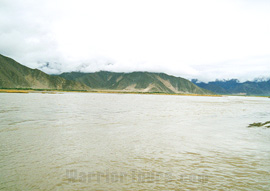- Introduction
Nyingchi Introduction
Nyingchi, called 'Jiangnan of Tibet' (Jiangnan generally refers to the picturesque southern region of the lower reaches of the Yangtze River), is a fertile green land in southeastern Tibet . Due to the relatively low altitude and mild and moist climate here, it is often chosen as the first des tina tion to acclimatize oneself for challengers to Tibet , the 'Roof of the World'.
Nyingchi is situated in the middle and lower reaches of the Yarlong Tsangpo River , the highest river in the world. This green land is surrounded by se vera l huge mountain ranges, including Mt. Nyainqentanglha to the north, the Himalayas to the south and Hengduan Mountains to the east. The a vera ge altitude here is about 3,000 m (10 thousand ft.) while the lowest point is only around 900 m (3 thousand ft.). The three typical climates of tropical, temperate and frigid zones can all be seen in Nyingchi. The months from October to April would be the preferred season to visit here to avoid the rainy and foggy seasons.
Nyingchi boasts much in its charming natural scenery. In this favorable region, it is possible to see various landscapes, such as year-round snow capped mountains, legendary holy lakes and rivers, unfathomable canyons and valleys as well as the expansive green grasslands. Mt. Namcha Barwa , the highest peak in this region, is always a must-see for visitors for its charming and mystical look. The Great Canyon of Yarlong Tsangpo River is the deepest canyon in the world, while Mt. Bon-ri , the said cultivated place for the founder of Bon, Tonpa Shenra Miwo, is also a resort for pilgrims. The enchanting Basum Lake also mark s a sacred spot for religious people to pay homage to.
Nyingchi teems with many virgin forests and rare plants, giving it the laudatory title of ' Inartificial Natural Museum' . The Tibetan cypresses, tree ferns - the called 'Living Fossil of Plant', Himalayas' firs and Shergyla Mountain's aza lea s form particularly splendid scenery in Nyingchi. It is also common to see other economic plants of wild bananas, wild pineapples, agarics, mushrooms and bamboos as well as medical plants of caladiums, snow lotuses, Ganoderma Lucidum, cordyceps among others. In addition, the region is also the home to many wild animals, such as the lesser pandas, snub-nosed monkeys, antelopes, bears, tigers, etc.
There are also some important towns in the region that are worth of visiting. Bayi Town , the administrative centre of Nyingchi, is a most charming spot that should not be missed. Pemako , the only county in China that is inaccessible by road, also attracts many backpackers for its virgin traits. In Nyingchi, there are inhabited 10 nationalities, including Han, Tibetan, Menpa, Luopa, Deng and others. The traditional customs and religious beliefs that the minorities have retained also provide an attraction for this region. The Buddhist Lamaling Monastery and cliff sculptures of Mt. Bon-ri are two famous cultural sights that you can pay a visit to. Menpa's wooden bowls and bamboo basketries, Luopa's stone pots and potteries can be ta ken back as souvenirs. The food here is also very plentiful. Apart from the common chang, T sam ba, Yak Butter Tea, it also offers many other unique ethnic foods.
![]() Must-sees in Nyingchi
Must-sees in Nyingchi

![]() Yarlung Tsangpo River
Yarlung Tsangpo River
The Yarlung Tsangpo River originates from a glacier in the northern Himalayas. Running 2,057 kilometers (1,275 miles) through Tibet, the river passes into India, known as the Brahmaputra, and finally meets the Indian Ocean in Bay of Bengal. With an altitude of 4,000 meters (13,120 ft), the Yarlong Tsangpo River is the highest in the world!
Yarlung Tsangpo Canyon is located at the sharp bend further downstream. The length of this great canyon is 496.3 kilometers (about 308.4 miles), even longer than the Grand Canyon of Colorado! The deepest point is surprising for 5,382 meters (about 17,657,480 ft) is indeed the deepest canyon in the world. The the canyon is still unexplored due to sheer mountains and torrential rivers.
Local Menpa and Luopa people still live a primitive life in this virgin land. Visitors could stay overnight with them to experience their simple, unfettered lifestyle.

![]() Basum Lake
Basum Lake
Basum Lake lies 90 kilometers (56 miles) west of Kongpo Gymdo County. The altitude of Basum is 3,538 meters (about 11,608 ft), and has a maximum depth of 60 meters (about 197 ft). The lake is also known as Tsokou, meaning 'green water' in Tibetan. Clear, green water reflecting the surrounding snow capped mountains makes an area of picture postcard beauty. Basum Lake is the holy lake of the Red Hat Sect, and a big rock situated to the northwest of lake has magical properties. People believe that if one pass through the hole in the middle of the rock, illnesses and misfortunes would be cured. There is a small islet exists in the lake on which a monastery built in 17th century that still worships Maitreya and Chenrezi inside. In 1997, the World Tourism Organization listed Basum Lake as a world tourist site.
Admission Fee: CNY50 (Nov.1-Mar.30) ; CNY100 (May 1-Oct.31)
![]() Accommodation
Accommodation
Bayi Town is equipped with various standards of hostels and guesthouses. Travelers to Basum Lake can stay at the new vocation village while at the local houses of villagers to the Great Canyon. Besides you can also pitch a tent.
![]() Transportation
Transportation
There is a direct air route between Nyingchi and Chengdu, a cruise every Friday. Travelers flying to Lhasa can take the regular bus to Nyingchi, however, it is recommended that you hire a car there, so that you have more flexibility to appreciate the attractive scenery along the way. In Nyingchi, you can also hire a jeep at the post office of Bayi Town to see some main attractions there.

